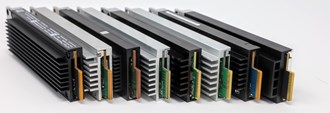Tech Talk
EDSFF continued: E3.S & E3.L introduction

Last updated 14 November 2022
The server landscape is changing as new environments and demands appear. For cloud service providers, data centres and edge deployers, the make up and footprint of the server/rack today has changed drastically in the last decade, in pursuit of consolidation and greater density.
As new technologies develop - IoT, M2M, Edge etc - more efficient flash drives come along to meet the demands and makeup, including the E1.S & E1.L as mentioned in our Tech Talk earlier this year. For years, the 2.5"/U.2 SSD, be that SATA or NVMe, has been standard practice for server infrastructures, as has rightly earned a great reputation and value for many server environments. However, the game must move on and new form factors from EDSFF family are providing this innovation - including the E3 form factors, which we will discuss in more depth in this article.
What demands can E3 form factors meet?
EDSFF haven't been spun out of nothing. The needs come from data centres and their rapidly evolving architectures. For many infrastructure reads, they'd be surprised to know just how many challenges these new breed of SSDs can not only meet, but exceed - as per the below:
Sustainability
As we will discuss, E3 form factors will allow for greater system density. With servers, everything is getting hotter and faster, so E3 and its characteristics for a more sustainable option with improved thermal and cooling abilities.
Signal Integrity
The next generation of interfaces continue to evolve with the adoption of PCIe 4.0 and soon PCIe 5.0 coming fast. The E3 form factors must and can support minimum PCIe 5.0 and PCIe 6.0 - and ideally beyond this.
Architecture Flexibility
Continuing on from signal integrity, E3 supports device link options up to x16 within the same chassis, accommodating power profiles from 25W to 70W, supporting a range of devices (not just SSDs), but NICs, GPUs, FPGAs, SCM and CXL devices, as well as low-end accelerators.
Size & Density
Be it a 1U server or a 2U server, the E3 form factor will work well as server architecture goes, being able to support multiple mechanical sizes and host link widths. As for density, there is no doubt that higher system densities can be achieved by using what is a simply a denser form factor to create miles better efficiency.
The E3 Family
| Variation | Power | Height | Length | Width |
| E3.S | 25W | 76mm | 112.75mm | 7.5mm |
| E3.L | 40W | 76mm | 142.2mm | 7.5mm |
| E3.S 2T | 40W | 76mm | 112.75mm | 16.8mm |
| E3.L 2T | 70W | 76mm | 142.2mm | 16.8mm |
Use cases
E3.S - Primary form factor for mainstream NVMe server storage subsystems.
E3.L - As above but for platforms requiring max capacity for each ‘U’ config that need a deeper chassis.
E3.S 2T - Made for higher performing NVMe, CXL, SCM and computational storage requirements.
E3.L 2T - Made for FPGAs and accelerators, with support for x16 PCIe lanes and 70W power profiles.

Systems supporting E3 form factor
New forward-thinking server systems are coming meet the demands of data anlytics, AI, IoT etc. - with the latest coming from Dell with the PowerEdge AMD Genoa Servers. The servers including Dell PowerEdge R7625, R7615, R6625 and R6615.
The servers can take up to 32x E3.S, compared to available of just 12x traditional 2.5" SSDs. A lot more storage.
As well as Dell, HPE have announced new ProLiant Gen11 servers with AMD Genoa (which is the key factor in the new OEM push here) - with support for 20x E3.S SSDs in the front, doubling up the storage potential - comparing to the limitations of just 10x U.2 design SSDs.
For edge, AIC has a new server platform powered by 4th Gen AMD EPYC processors which will make its debut in Q422 like the systems mentioned above as we head into this new era of data centre systems suitable for DDR5, CXL, EDSFF and meeting the workload demands of today. Options include 8 drive bays for E3.S, E1.S or traditional U.2.
E3 form factor SSDs on the market
SSD manufacturers have been holding off until news around system to release to house this form factor arrived - which is duly has done in Q422.
Whilst there isn't really any options on the market for E3 right now, expect news from our server SSD vendors in the near future - which we will update here in this Tech Talk!